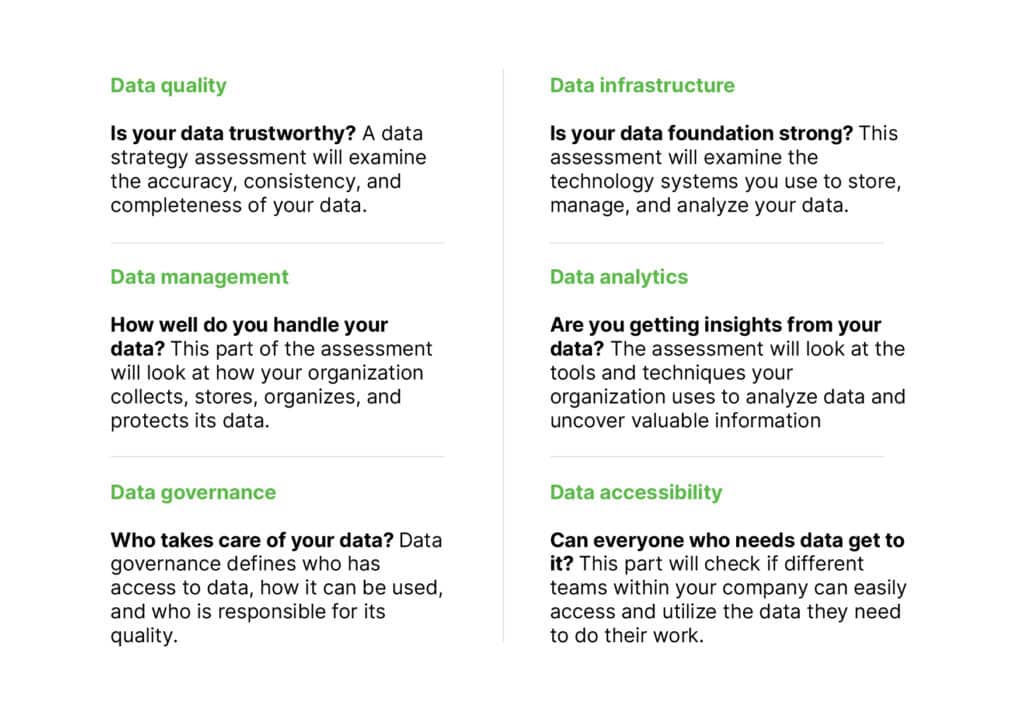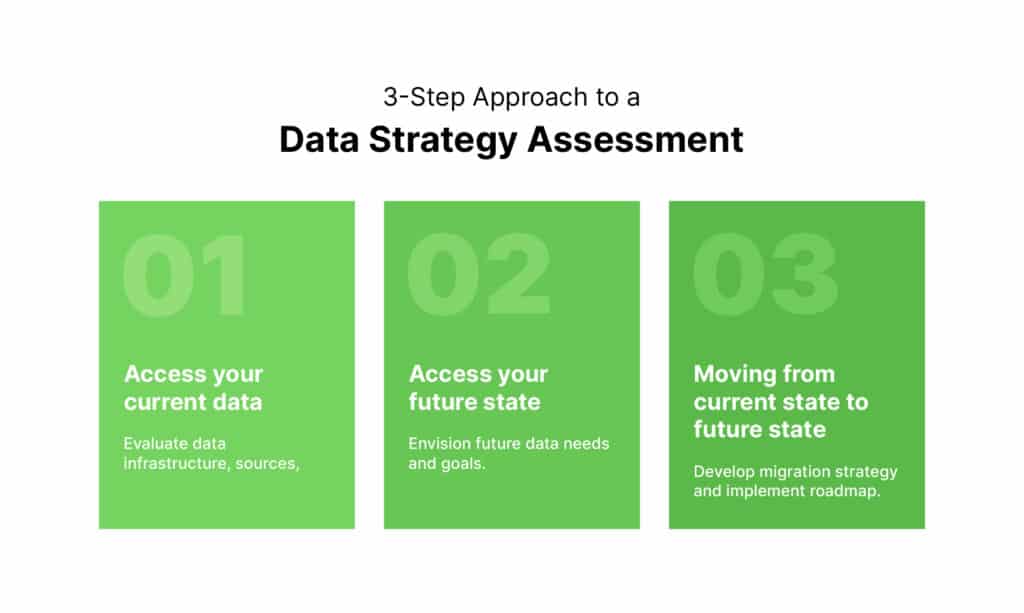
Data & AI Evangelist

Principal Data Architect
Subscribe to the newsletter
Businesses generate vast volumes of data daily. According to an estimate, by 2025, 181 zettabytes of data will be produced worldwide. Which is huge!
Naturally, where there’s data, there are challenges. Data integrity, reliability, validity, data timeliness, silos, and management are some of the common challenges that consistently confront data strategists, data architects, CTOs, and CIOs. Amidst these challenges, businesses often question the quality of their data, wondering if it’s useful enough to drive business value and support data-driven decision-making.
After all, data is only valuable when put to use. Unfortunately, issues such as incomplete, siloed, duplicated, and outdated data can keep a business from making the most of it. Establishing a data strategy, however, can help address these issues and more.
This explains why businesses are increasingly approaching data strategy assessment to identify strengths, weaknesses, opportunities, threats and close any gaps within their data ecosystem. In a recent study based on data analytics adoption, IDG predicted that 78% of business executives believe that data analytics will change the business operations in the next three years. Only 46% of business leaders have a well-defined and communicated data analytics strategy. Considering this gap, data strategy assessment has become more imperative for businesses in the age of data and AI.
This blog touches upon what, why, and how of data strategy assessment, equipping you with the right knowledge to build a roadmap for successful data strategy.
What is data strategy assessment?
Data strategy assessment is a structured review process that provides insights into an organization’s data maturity within its data ecosystem. It is a comprehensive evaluation of an organization’s data-related processes, systems, and infrastructure to determine their effectiveness and alignment with strategic objectives. This assessment typically involves reviewing data governance practices, data quality, data management procedures, technology architecture, and overall data strategy alignment with business goals.
The goal is to identify strengths, weaknesses, opportunities, and threats related to data management and provide recommendations for improvement to optimize data utilization and drive business value. In simple words, data strategy assessment process aims to take a deep dive into an organization’s data pool to assess its health and identify areas for improvements.
As explained above, a well-executed data strategy assessment includes evaluating:

By carefully accessing these factors your business is more likely to identify gaps and inefficiencies in your existing data pools and uncover opportunities for improvement.
Why should businesses conduct data strategy assessment?
The whys of data strategy and assessment cannot be understated.
A data strategy assessment gives you a clear snapshot of your data landscape and looks for areas of improvement. It plays a critical role in ensuring that organizations have the right data, of the highest quality, available at the right time, to support their business objectives and drive success.
Furthermore, data strategy assessment fosters a data-driven culture within an organization. Through data maturity assessment, a business can:
- Identify weaknesses
Data assessment strategy helps identify weaknesses and gaps in the organization’s data infrastructure, such as data quality issues, inefficient data management practices, or data silos. Through this information, an organization can create targeted strategies to address the identified issues and ensure their data is accurate, accessible, and effectively utilized.
- Improve decision-making
A data strategy assessment ensures that the data used for analysis is accurate, reliable, and relevant to the decision-making process. By implementing data management best practices, organizations become more confident about their data to make decisions with the insights they need to drive business success.
- Enhance competitiveness
With a robust data strategy in place, organizations can gain a competitive edge by leveraging data to drive innovation, improve customer experiences, and respond swiftly to market changes. By staying ahead of the curve with innovative data-driven approaches, organizations can differentiate themselves from competitors and capture market share.
How does a data strategy assessment work: A step-by-step guide
Data strategy assessment evaluates your current data landscape, outlines a roadmap for future goals, and helps outline a strategic plan to bridge the gap between the two.
Let’s guide you through a three-step data strategy assessment process. This will chart a course toward a future where data is strategically leveraged to drive success within your organization.

Step 1: Assess your current state
Your business can only generate an outcome in the future if you have a clear understanding of your current data landscape.
To assess your current situation, it is important to thoroughly evaluate your existing data infrastructure. This will help you gain a comprehensive understanding of how data is currently managed and used within the organization. Key questions that should be considered throughout the initial state of data assessment include:
What data sources are currently being used within the organization?
- How is the data collected, stored, and managed?
- What is the data maturity level within your organization?
- What are the primary challenges within your current data infrastructure?
- What existing data governance frameworks or procedures are in place?
Answers to these questions will give you a clear picture of your current data infrastructure and lay the foundation for strategic planning moving forward. Now, it’s time to utilize your data assessment.
Step 2: Assess your future state
The next step focuses on the shift toward leveraging the data insights to envision and a plan for the future. This means identifying how data can be used to support your business goals. Data sources can be both internal and external sources to help you meet your objective. Regardless of the data source you choose, make sure it is accurate and possesses high-quality standards. Key considerations during this stage include:
- Long-term data goals of the organization
- New data sources and technologies
- Data-driven needs
- Types of analysis required
- Timeline and budget
Synthesizing all these considerations into a coherent plan will equip your business to leverage data effectively and drive sustainable growth and innovation.
Step 3: Migrate from current state to future state (future data strategy)
Since you now understand your data journey’s current state and identified all the gaps, the best course of action is to take a leap forward. Migrate from the current data infrastructure to a modern data platform that aligns with your business objectives. Keep in mind that moving your data should not disrupt your business. Rather they should plan the migration to ensure a seamless transition to a modern platform.
Snowflake, Microsoft Fabric, Databricks, and Azure are some of the major data modernization platforms that make your business data fit for the future. However, the right choice depends on your business objectives and data strategy needs.
Moving to modern data platforms empowers you to bridge the gap between your current state and your data-driven future. It also provides a multitude of benefits that will surely propel your business forward.
How to build a data roadmap with data strategy assessment?
Once your organization has performed a data strategy assessment, you will have a data strategy roadmap. This roadmap will act as a guiding compass for your business to build a better future with data. This roadmap will include:
1. Data migration strategy
For migration strategy, you need a detailed plan for transitioning from the current data infrastructure to a modern data platform. A robust data migration strategy will ensure minimal disruption to ongoing operations while efficiently transferring your data to the new platform.
2. Data platform selection
Platform selection is another crucial aspect involving selecting the most suitable modern data platform that aligns with the organization’s goals and objectives.
3. Implementation
Lastly, the roadmap outlines the steps for implementing your chosen MDP. This includes resource allocation for technical teams or any necessary training to ensure a smooth transition and successful platform adoption.
Unlock data opportunities with Confiz’s data strategy assessment
A thorough data strategy assessment will give you an understanding of your current data landscape, the challenges you need to address and identify future opportunities. A data assessment is just the first step in developing a sound data strategy.
Ready to take the first step? Get a 2-week data platform maturity assessment with Confiz. Discover how we provide data strategy assessment consultation to know how we can empower your organization’s data journey towards success. For questions, reach out to us at marketing@confiz.com.



